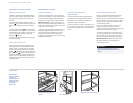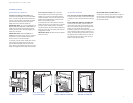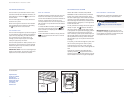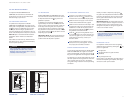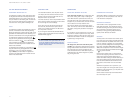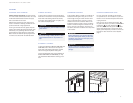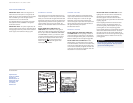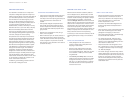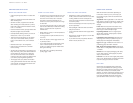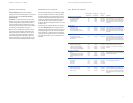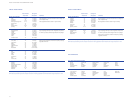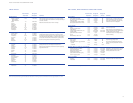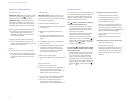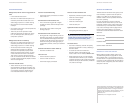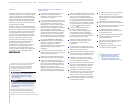16
KEEPING FOOD AT ITS BEST
KEEPING FOOD SAFE TO EAT
WHEN YOU PREPARE FOOD
•
Clean everything that comes in contact with
food.
• Wash your hands for 20 seconds before and
after handling food.
• Sanitize counters, equipment and utensils
after handling raw meat, seafoodor poultry.
R
inse with a diluted chlorine bleach solution,
5 ml to 1 L of water.
• Use clean kitchen towels, sponges and cloths.
Replace sponges every few weeks.
• Use disposable plastic gloves if you havean
infected cut or burn on your hands.
• Thaw food in therefrigerator or microwave
oven, not on thecounter. When you thaw
food in a microwave oven, cook it immedi-
ately.
• Marinate foodonly in therefrigerator.
• Rinse poultry and seafood in cold water
before cooking.
• Avoid cross-contamination inpreparing food.
Keep raw meat, poultryand seafoodand their
juices away from other food. For example,
don’t use the same surface and utensils for
preparing rawmeat, poultry and seafood that
you use for preparing salad ingredients.
• Thoroughlyclean your plastic and wooden
cutting boards. Wash with hot water and soap
and rinse with a diluted chlorine bleach solu-
tion of 5 ml to 1 L of water.
WHEN YOU COOK FOOD
•
Cook meat to aninternal temperature of75˚C
or above, poultry to 80˚C or above. For cuts
m
ore than 51 mm thick, use a meat ther-
mometer tocheck the temperature.For
thinner cuts, clearjuices (notpink) are a sign
of doneness.
• If you arecooking frozen meat or poultry that
has not been defrosted, increase the cooking
time to 1
1
/
2
times the time required for
thawed items.
• Roast meats or poultry in oven temperatures
of 165˚C or above.
• Cook eggs until the yolk and white are firm,
not runny.
• Don’t use recipes in which eggs remain raw
or partially cooked.
• If your microwave has a temperature probe,
use it. Check temperatures of meat and
poultry inatleast threespots. Rotate foods
during microwaving.
• Don’t taste raw or partially cooked meat,
poultry, eggs or fish.
FRESH FOOD STORAGE
Shelf lifeoffresh foodsvaries depending on
h
ow fresh it is when you buy it. To keep your
food fresher longer, follow the recommended
storage tips.
Vegetables:
Wash vegetables in cool water and
drain. Store in airtight containers orplastic wrap.
V
egetables stay fresh longer in high humidity
storage.
F
ruits:
W
ash and dry fresh fruits. Storemore
aromatic fruits in plastic bags. Most fruits stay
fresh longer in low humidity storage.
Prepackaged Meats:
Store in original pack-
aging. After opening, rewrap tightly in plastic
wrap or aluminum foil.
Fresh Meats, Fish and Poultry:
Remove store
wrappings,then rewrapinplastic wrap, foil or
waxed paper and refrigerate immediately.
Eggs:
Store eggsunwashed intheir carton or a
portable egg tray. Use within 3 weeks.
Milk, Cream and Cottage Cheese:
Keep carton
closed. Store on refrigerator shelf and usewithin
1–2 weeks.
Cheese:
Store in original packaging until ready
to use. After opening, rewraptightly in plastic
wrap or aluminum foil.
Leftovers:
Let cool and cover tightly with plastic
wrap or foil. Airtight plastic containers work well
to preventdrying out andodor transfer.
ETHYLENE
Some fruits and vegetables will produce eth-
ylene, a gas that initiates the ripening process.
Ethylene can cause premature ripening in some
foods, while in others, it can actually cause
damage. To reduce unnecessary spoilage of your
fresh produce, do not store ethylene producing
fruits andvegetables with those that are eth-
ylene sensitive. Refer to thechart on page 18.
WHEN YOU HAVE LEFTOVERS
•
Refrigerate or freeze cookedleftovers in
small, covered containers within 2 hours after
c
ooking. Make sure there is adequate air
space around the containers so that food can
cool down quickly.
•
Remove thestuffing from meat or poultry and
store it separately.
• Date packages of leftovers and use within a
safe period of time.
• Cover and reheat leftovers thoroughly before
serving.
• Bring sauces, soups and gravy to a boil. Heat
other foods to 75˚C.
• If you think food may be spoiled, discard it.
When in doubt, throwitout.



